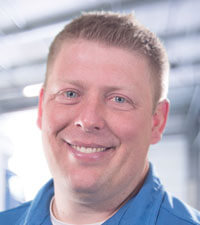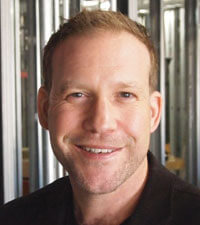Eco-Efficiency in Omaha, NE
Linking environmental and economic performance, eco-efficiency is a key part of the successful management of a modern business/organization.
A key sustainability concept, eco-efficiency takes into consideration all of the integral parts of your business—the actual day-to-day functions—and how those components can be further optimized for the preservation of the environment while also positively impacting the business’s bottom line. Furthermore, when we use the term “environment,” it actually has a two-fold meaning: on a small scale, the environment that you do business in itself, and on the largest scale, our global environment.

Pat Killeen
Engineered Controls
“Today more than ever, building owners want their facilities to be environmentally responsible and healthy places to live and work,” emphasizes Pat Killeen of Engineered Controls. “They also want to optimize the energy usage, without compromising comfort. Together a tall order to accomplish, but at Engineered Controls that technology is available today. Furthermore, we benefit greatly from our partnership with Honeywell, a major energy products company that is spending sizable research and development funds on new products that will improve our lives and reduce energy.
Engineered Controls can play a very big part in assisting new and existing building owners with controlling their buildings’ energy costs. Considering the fact that a building’s lighting and HVAC loads account for nearly 80% of a building’s energy usage, there are plenty of energy strategies that a Building Automation System can provide, maximizing the energy strategy options available to building owners. Essentially, Engineered Controls can assist in total building control and help provide a healthier and more energy-efficient environment for occupants.
To help our customers in identifying efficiency areas in their buildings, Engineered Controls, in conjunction with Honeywell Inc., developed an Energy & Environmental Optimization or EEO program. It is designed to leverage a broad portfolio of energy efficiency products and solutions, as well as offer a high level of energy expertise to commercial buildings in the hands of our skilled, knowledgeable and certified EEO professionals. Our EEO team can help building owners and managers obtain real-world data to help them make fact-based decisions about how to optimize their buildings for occupants’ comfort while saving energy at the same time.
Engineered Controls also offers our customers Planned Service Agreements (or simply PSA’s) to assist them in the daily operation of their facilities. The PSA that has two elements: 1. Preventative Care & Routine Maintenance; and 2. System-Wide Energy Analysis.
The first element focuses on the building hardware and is a standardized preventative maintenance program on a building environmental controls system to maximize the system’s reliability and to minimize the operational costs. In other words, our PSA program offers comprehensive system-wide checkups and testing to ensure that the control system is always operating at peak performance levels. Building systems that are properly maintained and controlled will enable you to focus on the core of your business while ensuring that everything is running efficiently. This also promotes longevity of equipment, protection of employees and equipment due to proper security measures, and energy efficiency which will result in minimizing operating costs and future unplanned capital expenditures.
For the second element, our staff of trained experts will assist a building owner in identifying areas where they can reduce cost, identify simple potential energy savings payback opportunities, and provide training. When our customers are interested a more aggressive approach to energy reduction, then we move them into our EEO program that was previously mentioned.
Moving away from the building equipment perspective and focusing more on the building occupants, indoor air quality (IAQ) is of great importance. This can be a major concern to building managers, employees and tenants because it can impact the health, comfort, well-being, and productivity of the building occupants. Having suitable indoor air quality in commercial buildings is an important component to the overall health of its occupants. Quality indoor air contributes to a favorable and productive environment for building occupants, giving them a sense of comfort, health, and well-being. Significant increases in worker productivity have also been demonstrated when the air quality was adequate.
Today in commercial buildings, automation systems exist that will monitor and control a buildings environment to look for possible contaminates. The building automation system can also monitor human exposure to pollutants (e.g. carbon dioxide, carbon monoxide, radon, volatile organic compounds and more) that can have adverse effects on your workers’ health. For example, high levels of carbon dioxide can cause drowsiness and create an inefficient work environment for building occupants, whereas other toxic gases like carbon monoxide are hazardous and potentially fatal for workers if not treated quickly. To combat all of the indoor air problems that are present, Engineered Controls offers a Demand Control Ventilation software program that will automatically adjust HVAC systems to introduce higher levels of outdoor air only when occupancy levels of building contaminants are at a high level. Equally important is that these features only induce more outdoor air when required, thus allowing building owners to maintain optimum levels of IAQ and at the same time obtain substantial energy cost savings while increasing the comfort and productivity of occupants.”

Aaron Ruskamp
Thrasher
“As radon and harmful vapors have gained more attention, especially in our area of the country, there has been an increased focus and regulation related to indoor air quality in commercial buildings,” adds Aaron Ruskamp of Thrasher. “Nebraska and Iowa continue to rank in the top 5 for highest levels of radon. Because of this, air quality ventilation and mitigation has become more of a focus in the design and refitting of commercial buildings. Whether you are dealing with new construction or a 50-year-old building, Thrasher has ways to address these issues proactively or reactively.
We provide a variety of mitigation systems that address many aspects of indoor air quality, including radon, carbon monoxide, and other harmful vapors ranging from chemical pollutants to basic allergens in the environment. These all have varying degrees of influence on employees’ health and productivity within the workplace. Thrasher provides custom solutions to fit the varying needs we encounter. We do this by providing individualized inspections and assessment of the work environment in order to maximize efficiency and effectiveness. Working collaboratively with our commercial clients, we identify their primary goals while helping them understand what solutions are available to achieve the best working environment possible when it comes to indoor air quality.
Many of our clients have the goal of reducing radon or other harmful vapors to the lowest level possible, and this is something Thrasher believes is possible. One way to do this is to use an Energy Recovery Ventilator (ERV) in conjunction with a traditional radon or vapor mitigation system. Aside from the benefits of air quality, these systems have markedly improved when it comes to overall performance of the actual unit. This is illustrated by a decline in air conditioning and heating energy costs, improved safety/health benefits, and greater ROI compared to other systems on the market.
Our focus is on providing practical, cost effective, and sustainable ways to improve and maintain indoor air quality. The mitigation system uses the amount of energy that a light bulb consumes in a year, and the ERV efficiently exchanges indoor air with fresh outside air while also having a positive effect on overall energy usage. As with anything, systems can be designed and/or installed poorly. The overall design should be well thought out, and the installation should be coordinated in conjunction with other contractors who may also be working in the building. It is important to choose a reputable company who is considered an expert in the industry in order to maximize use of the system while also ensuring the job is done right the first time.
While the focus of indoor air quality has historically been residentially-driven, with increased awareness, it only makes sense that we also consider the workplace as well. The ripple effect of fixing one building at a time can have a significant impact on a personal and global level. We believe in the idea that we should strive to reduce radon/harmful vapors to the lowest levels possible, not just what is recommended by the EPA or World Health Organization. This is critical in redefining the way we view the commercial workplace from an air quality standpoint.”
As previously mentioned, a good design is critical to the efficacy of the solution you are implementing—and in which you are making an investment. The professionals at Echo Systems are also well-known for customizing solutions for commercial buildings and bringing innovative concepts to life. This includes a multitude of different offerings from building control and automation to shading, lighting, and other aspects that add enhanced function but also have the potential to transform the overall look and feel of the space.

Doug Dushan
Echo Systems
“We offer a host of solutions geared towards helping businesses optimize their environmental efficiency,” explains Doug Dushan of Echo Systems. “Shading, lighting, automation and energy management solutions are among our most popular offerings. Our shading solutions help to promote productive environments, while also reducing the energy consumption businesses would otherwise leave untouched. Our lighting solutions, similar to our shading solutions, also impact the energy consumption. By focusing on task lighting, spaces can be lit appropriately and in conjunction with shading solutions, will help to maximize ambient light, reduce utilities required, and provide an overall more pleasant environment, both to internal personnel and to the environment. Our automation and energy management solutions address the automation and sustainability of maximizing the energy efficiency of the space, while also providing live usage tracking and a historical overview of operations. To find out more, please reach out to our dedicated staff here at Echo Systems at (402) 334-4900 or stop in and tour our Customer Experience Center at 4315 S. 120th Street Omaha, NE 68137.”
Now that you have a taste of what’s out there currently, take a step back to look at the whole picture of your operations (and ecological footprint). You’ll find that there are many useful applications, and in all aspects of business, where eco-efficiency principles, tools, and processes can be applied. Whether it’s a small improvement or a large-scale solution, the outcomes are well worth at least looking into what you can do to improve your eco-efficiency. If you’re not sure where exactly to start, give one of our local professionals a call and go from there!

